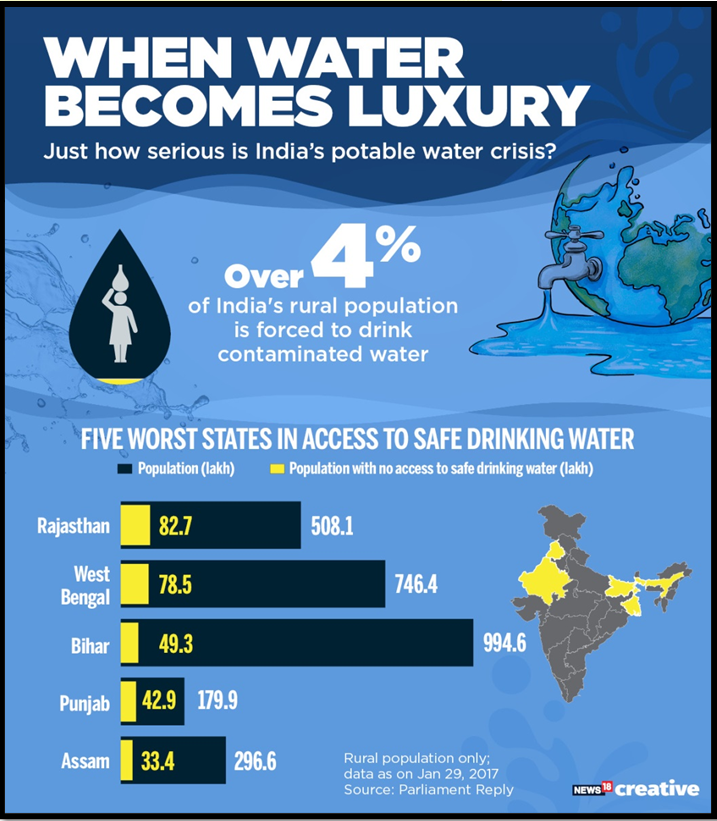PREPARING INDIA FOR WATER STRESS, CLIMATE RESILIENCE
SYLLABUS:
- GS 1: Important Geophysical Phenomena such as earthquakes, Tsunami, Volcanic activity, cyclone etc.,
- GS 3 : Climate Change and its effects.
Focus:
- Worsening water deficit in South India’s reservoirs, emphasizing the imminent water crisis.
Urgency of Water Stress Mitigation:
- Hotter Summers and Longer Heatwaves: Predictions by the India Meteorological Department (IMD) indicate an increase in heat intensity and duration, exacerbating water scarcity concerns.
- Transition from Reactive to Proactive: Shifting focus from emergency responses to regular, systematic preparedness against recurrent water-related stresses.
- Chronic Nature of Risks: Recognizing water stress as a persistent challenge that impacts the stability and functionality of various sectors.
- Broad-Based Climate Action: Emphasizing that effective climate resilience requires involvement beyond a few sectors or occasional initiatives, like tree planting.
- Significance of Earth Day: Using this day as a catalyst to highlight and address the intertwined challenges of climate change and economic sustainability.
Water’s Role in the Economy:
- Hydrological Connections: Understanding that water is a critical link between hydrological, food, and energy systems which collectively sustain millions.
- Impact on Agriculture: Water availability directly affects agricultural productivity, which is vital as agriculture employs approximately 45% of India’s population.
- Climate Vulnerability of Employment: The sector’s sensitivity to climate changes threatens job security and economic stability.
- Influence of Monsoon Variability: Increased instances of erratic, heavy rainfall disrupt traditional farming cycles, necessitating adjustments in agricultural practices.
- Energy Sector Integration: Highlighting the role of water in clean energy transitions, such as in the production of green hydrogen and the operation of pumped storage hydropower systems.
Addressing Hydrometeorological Disasters:
- Rising Incidence of Water-Related Disasters: Reports by the UN and CEEW indicate a significant increase in floods and other water-related events, underscoring the need for enhanced preparedness.
- Planetary Boundaries and Water: Recognition that freshwater limits have been exceeded, posing additional risks to sustainability and health.
- Infrastructure and Response Needs: The necessity for robust infrastructure that can withstand the severity and frequency of these disasters.
- Educational and Awareness Programs: Developing programs to increase public awareness and knowledge on managing water resources effectively.
- Policy and Emergency Preparedness: Urging the creation and implementation of comprehensive disaster management plans that integrate climate resilience.
Strategies for Ensuring Water Security:
- Integrative Water Governance: Policies must acknowledge and incorporate the interdependencies between water, food, and energy systems.
- Efficient Water Use and Reuse: Promoting practices like the reuse of urban wastewater and improving overall water use efficiency to meet the National Water Mission goals.
- Water Accounting and Data Management: Establishing robust mechanisms for tracking water usage and savings across sectors to enable targeted and effective conservation efforts.
- Investment in Adaptation Technologies: Encouraging the adoption of technologies such as micro-irrigation systems, crop diversification, and desalination to enhance water security.
- Community Engagement and Localized Solutions: Tailoring solutions to local conditions and involving communities in the decision-making process to ensure sustainability and acceptance.
Financial Frameworks for Climate Adaptation:
- Increasing Adaptation Funding: Recognizing the disparity between investments in climate mitigation and adaptation, particularly in water and agriculture sectors.
- Leveraging Corporate Social Responsibility (CSR): Utilizing CSR funds to invest in water security and climate resilience initiatives, potentially unlocking significant capital annually.
- Market Innovations: Exploring new financial instruments like India’s Green Credit Programme to attract investments into water management and agricultural resilience.
- Global Financial Collaboration: Drawing on international funding and partnerships to enhance local capacities for managing climate impacts.
- Building Economic Resilience: Integrating financial tools and policies to create a robust economy that can withstand and adapt to the challenges posed by climate change and water stress.
Moving Forward:
- Adopting a Comprehensive Approach: Addressing the water crisis in southern India necessitates a multifaceted strategy. This includes implementing sustainable water management practices, conservation measures, investing in water infrastructure for storage and distribution, promoting water-efficient technologies, and conducting public awareness campaigns to encourage water conservation.
- Embracing the One Water Approach: Integrated Water Resources Management (IWRM), also known as the One Water Approach, entails managing water sources in an integrated, inclusive, and sustainable manner. This involves collaboration among various stakeholders, including the community, business leaders, industries, farmers, conservationists, policymakers, academics, and others, to achieve ecological and economic benefits.
- Promoting Water-Efficient Farming Practices: Encouraging farmers to adopt water-efficient farming techniques such as drip irrigation, precision agriculture, crop rotation, and agroforestry can significantly contribute to water conservation efforts. According to the MS Swaminathan committee report on ‘More Crop and Income Per Drop of Water’ (2006), drip and sprinkler irrigation methods can save approximately 50% of water in crop cultivation while increasing crop yields by 40-60%.
- Coordinated Efforts: Coordinated actions at the national, state, and local levels are imperative to mitigate the impacts of water scarcity and ensure sustainable water resource management for future generations. Collaboration among government bodies, civil society organizations, private sector entities, and local communities is essential to address the complex challenges posed by the water crisis effectively.
| India Meteorological Department (IMD):
About:
Roles and Responsibilities:
|
Source: The Hindu
Mains Practice Question:
“India’s vulnerability to climate change is intricately linked to its water stress issues. Discuss the interconnectedness between India’s water stress, agricultural dependency, and energy needs. Analyze the implications of these interdependencies on India’s disaster preparedness and climate resilience strategies. Suggest measures that can be adopted to strengthen India’s resilience to climatic shocks and ensure sustainable water security.”
Associated Articles:
https://universalinstitutions.com/water-crisis-intensifies-in-south-india/




